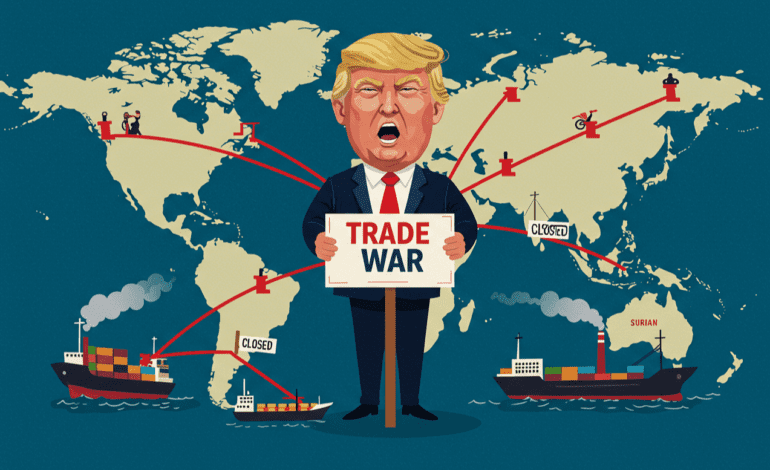
Trump initiated a worldwide tariff storm which launched a new trade conflict affecting India and the rest of the world.
U.S. President Donald Trump launched a global economic disruption through his widespread new tariff policy that targets countries worldwide during his second attempt to influence international matters. A diplomatic trade conflict occurs in this situation rather than a minor battle. A significant global trade war which has not occurred in at least three decades seems to initiate from the current events.
The aggressive tariff policy creates effects throughout India which cannot be overlooked by its citizens. The global strategy launches a course shift in worldwide trading dynamics that affects trading alliances globally and results in higher product prices across New York to New Delhi.
We will examine Trump’s strategy from various angles including his strategic motivations and economic impacts on India and other global nations and foreseeable economic implications.
Trump’s Latest Move
This recent installment of tariffs by Trump extends beyond several specific nations. It’s a global play.
Uncle Sam will impose identical tariffs on other countries after they hit American exports with a tax of 20%. The actual numbers implemented across the board exceed the proclaimed figures. China currently must bear a 34% tariff on electronic devices as well as machinery and steel products originating from the United States. The tariff policies implemented by Germany, Japan, South Korea, and moreover U.S. allies UK and Canada stand between 10% to 50%.
Through import taxes Trump aims to raise the prices of foreign products available in the U.S. so that Americans will do their purchasing from domestic suppliers. The policy embodies America First doctrine through complete economic means.
Why Is Trump Doing This?
The basis of these tariffs comes from some fundamental beliefs that President Trump embraces:
- Trump fights against trade imbalances by stating that China and other nations have held dominant trade surpluses through American industry sacrifice. His tax policy aims to bring balance between China and the United States through these new tariffs on Chinese exports.
- Trump thinks higher import costs will reconstruct local manufacturing and create more employment in traditional industries throughout states primarily dependent on old-style industries.
- The tariffs function as a pressure mechanism which aims to force countries into reinstating trade negotiations for enhanced trade deals with the United States.
What expenses will be endured by such actions?
The implementing of tariffs produced a worldwide economic disruption across important nations.
This tariff wave specifically targets China as its largest target which represents both economic and strategic challenges for the country. The export-driven economic model of the country depends heavily on open access to worldwide markets but particularly to the United States. Chinese manufacturers anticipate severe losses because of 34% tariffs that continue to disturb their supply chains.
Europe, too, is rattled. Germany encounters increased production expenses and weaker market positions for their industrial exports consisting of vehicles and heavy machinery and technology products in the American marketplace. South Korea, Taiwan and Japan which specialize in automotive parts and electronics production rush to change their business strategies.
The updated NAFTA agreement named USMCA fails to provide protection for its two signatories Canada and Mexico. Many perceive this approach as a Trump-administration policy that breaks international trade deals to boast American economic strength by forcing others into submission.
What About India?
Now, let’s bring it home.
India experiences impacts from this tariff tsunami although it remains secondary to the main targets. The United States has started charging import duties to pharmaceuticals as well as textiles and auto components and it also includes IT services. The imposed tariffs on Indian exports do not match those against China however they present enough of a challenge to weaken our export performance in the U.S. market.
India generates more export earnings than import costs in trade with the U.S. while IT services, pharmaceuticals, gems and jewelry contribute substantially to these exports. Indian exports might become uncompetitive in the American market when tariffs are applied to these specific products thus decreasing their demand.
India faces difficulties with its Make in India and “Atmanirbhar” Bharat objectives because of this present scenario. The implementation of Trump’s tariffs helps decrease Chinese products’ competitiveness while creating a business window of opportunity for export companies in India. The growth of worldwide trade barriers would reduce international demand which affects India because it depends mostly on exports for its economic success.
Is This a Trade War?
The short answer: yes.
The deliberate economic decision developed into a worldwide struggle representing dangerous confrontations. Multiple nations have begun discussing retaliation through trade tariffs. Chinese officials have indicated their plan to apply taxes against U.S. agricultural exports together with semiconductor products. European authorities are evaluating the implementation of duties on American technology companies. Canadian government officials alongside other allies are developing countermeasures in response.
Trade conflicts emerge when countries employ their first economic countermeasures which eventually degrade the economic state of all participating nations. These external circumstances decrease worldwide economic expansion while markets experience downturns and numerous employment rolls vanish and consumer prices increase.
The Bigger Picture: Global Economic Fallout
The global economy faces several macroeconomic consequences due to Trump’s implementation of tariff measures.
The regulatory measures will impact global supply operations particularly within the technological sector and energy systems and manufacturing industries.
The price rise will impact consumers throughout the world as well as in the U.S. That $800 smartphone? It might soon cost $1,000.
Business investment confidence declines when organizations dislike uncertainty since volatile policies create an unfriendly environment for growth.
The protectionist measures implemented by Trump will coerce nations to regress toward previous isolationist trade policies which started from decades of multinational collaboration.
Research by the OECD predicts that rising trade tariff wars could cause worldwide economic growth to decrease by a rate of 1% throughout the following year. Indian economies face the risk of diminished export numbers and reduced foreign direct investment and wild fluctuations in stock values and currency prices.
So, What Should India Do?
The latest worldwide economic situation has placed India in a position where it must strike the appropriate balance.
India should use foreign market expansion as a strategy to decrease U.S. and Chinese dependency while pursuing opportunities in African, Latin American and Southeast Asian territories. India takes progressive steps toward trading expansion through its newly established trade relationships with Australia and the UAE.
India needs to increase the competitiveness of its domestic operations. The upcoming cutthroat nature of global trade demands India to prepare its industrial sector to compete through both cost efficiency and quality and innovative capabilities.
India must maintain bilateral relations with China and the United States to achieve strategic independence and demand equal trade conditions. When emerging as a leading global power India can serve as a linkage to facilitate discussion and reduce rivalry between dominant economic nations.

Final Thoughts
The new American trade policy adopted by Trump creates problems beyond American borders which scrape the foundations of worldwide globalization. This policy challenges the progress made through trading globalization since it has commenced. Trump’s mission to defend American jobs through rebalancing trade may lead to serious negative impacts which could harm the country more than expected.
India faces both difficulties together with possibilities from this situation. The short-term export decline we will probably encounter can become an opportunity when we wisely diversify our markets and develop new products and effectively negotiate with other countries.
The world of trade has begun an irreversible change that needs us to adapt.





